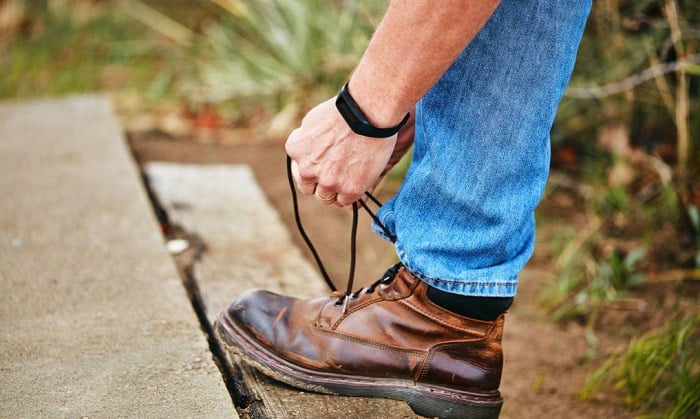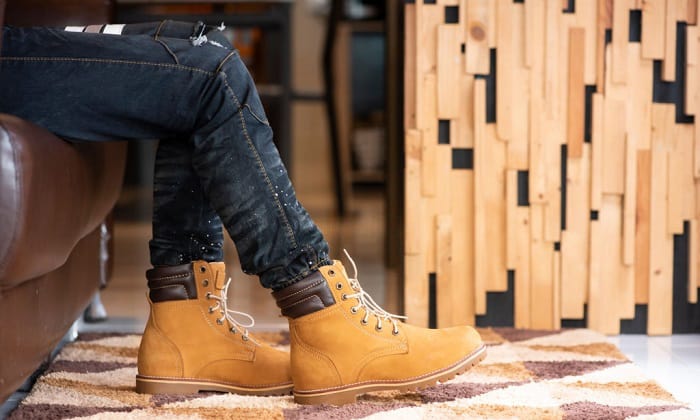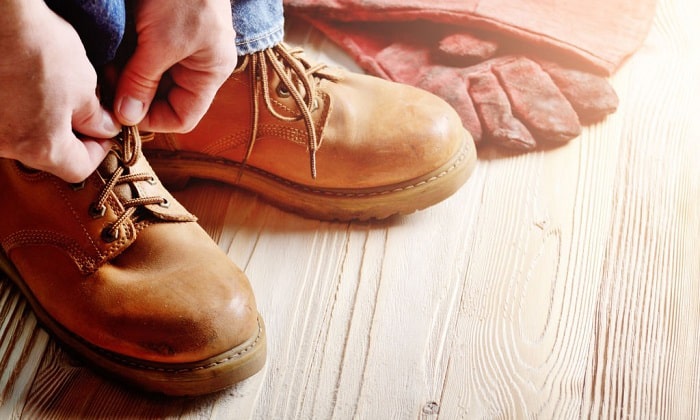The first time you wear leather work boots, they might feel painful and uncomfortable. That is normal because of the heavy and sturdy nature of safety footwear. The problem will be solved once you take your time to break in the leather boots. No pressure though! Breaking in work boots is simple.
Firstly, you need to get the proper size and adjust until they are well-fitted. Then, spend time wearing them around the house. It should take at least 15 to 20 minutes a day for a few days. To further stretch the leather, pair the boots with thick socks and use leather conditioners. Finally, store them using shoe stretchers for the best results.
After the break-in period, your feet will have more room to breathe and flex in the boots. Common foot problems like foot strain, ankle pain, blisters, and chafing won’t happen. Trust me, it’s worth the effort. Let’s explore further on how to break in new work boots fast.
Table of Contents
What You Will Need
The OSHA makes it mandatory for workers to wear safety boots at certain worksites. You can’t avoid them no matter how unpleasant they might feel. But with these steps, comfy work boots are guaranteed. Quickly gather the following to proceed.
1. Your new boots
Your new pair of boots is certainly what you will need. Go ahead and grab them. However, you can only break in boots that fit or are just a bit tight. There’s no way to stretch a shoe from size 7 to 9, or shrink a size 10 to size 8. Kindly check the fitting of your boots:
- When you stand, your toes should have at least a one-inch room in front of them.
- When you walk, your heel doesn’t come up too high or out of the boots. The toes shouldn’t slide forward and hit the toe box.
- When you carry something heavy, the sides of your feet shouldn’t feel the shoe pressure.
Later in this article, we will provide tips to buy the most comfortable and properly-fitted boots. For those who don’t own a good pair of boots yet, keep reading.
2. Thick socks
Not every pair of socks will work in this scenario. Remember that we are dealing with heavy-duty footwear. Some work boots can weigh up to five pounds. That is a relatively large amount of weight on the feet. Hence, prepare a nice pair of socks. If you blindly pick any socks in the supermarket, chances are they are not of high quality. To choose absorbent and durable socks, pay attention to these:
- Materials: Cotton is a common material in the clothing industry, but not necessarily the best when it comes to socks. Even though more cost-effective, cotton is not as moisture-wicking and breathable as polyester or synthetic blends. For those who prefer natural fabric, bamboo or merino wool are great. They won’t trap moisture in your feet.
- Fit: Socks are stretchy, but it doesn’t mean any sock will fit. Pay attention to sizing when buying them. The socks should fit snugly, not tightly. If the socks are loose, redundant fabric can cause blisters.
- Thickness: To break in leather boots, you need thick socks. They can provide more cushioning than regular ones. But if your boots are a bit tight, be mindful not to buy socks that are too thick. The combination of tight boots and thick socks will strain your feet.
In addition, some socks feature paddings in the ball and heel of the feet. Look for these if you want extra support and comfort.
3. Shoe stretchers
It is never easy to find well-fitted shoes. The safety features of work boots make it even harder. If you often find yourself landing between two shoe sizes, boot stretchers are a good investment. They will be useful for your work boots and the rest of your shoe cabinet.
Some boot stretchers come in pairs, one for the right shoe and one for the left. Some can be bought as singles; you can use one for both shoes. Also, for high neck boots, consider boot calf stretchers to get the best results.
4. Leather conditioner
Leather conditioner will soften the upper parts so you can break in work boots fast. Moreover, new steel toe boots tend to crack in the toe box. Conditioner will help prevent leather cracks. Remember that once cracked, leather will lose its form and function. For instance, if you damage the leather surface of waterproof boots, water will easily leak in. The boots will soon wear out.
Once the leather is covered with the conditioner, dirt and dust can’t stick on the surface. The conditioner will lubricate the leather, giving it a more polished look. In case you only have mink oil, you can use it. But be aware that mink oil can darken the leather’s color.
5. Bandaids
During the break-in period, slight blisters and chafing are unavoidable. Don’t ignore them as they might lead to more serious symptoms. Keep some bandaids handy in case you need them. They will keep the foot painful areas from rubbing against the shoes.
Steps to Break in New Work Boots
When you’ve gathered all you might need, let’s take action.
Step 1: Get the right fit
For work boots to feel comfortable, getting the right fit is crucial. Be aware that some boots run large while some run small, it depends on the brands and models. Never assume they are the same size as your other shoes. Instead, measure your foot carefully and compare it to the brand size chart for proper sizing.
If you can try on a new pair in store, ensure the boots fit by:
- Bring your own favorite pair of socks.
- Buy new boots at the end of your working day as the feet tend to be bigger after a long day at work. Do this to avoid tight shoes.
- When you have the boots on, try standing on your tip-toes. The toes should not hit the top of the boots and feel balanced.
Besides fitting, here are a few helpful tips to enhance comfort:
- If your feet easily get hot and sweaty, leave extra room in the toe box for breathability. You should opt for the wide or square toe designs.
- In case you are not sure about the most accurate size, buy lace-ups. They are easier to adjust than slip-ons. All you need to do is loosen or tighten the laces.
- Always think about the amount of foot support you need. People with high arches should buy work boots that have extra arch support. For people who experience plantar fasciitis (sharp shooting sensation in the feet), know that there are safety footwear specifically designed for the symptom.
- In general, steel toe work boots are heavier and harder than composite toe ones. If you are new to the world of safety gear, we recommend buying composite toe cap boots. Walk around the house
Step 2: Walk around the house
Now that you’ve got new boots that fit properly. Start by putting them on and walking around the house. This will help the shoes to soften and loosen.
Do this for 15 to 20 minutes a day, then gradually increase the time you spend wearing them. After a few days, your feet will start to feel much more comfortable. During this period, the leather is still quite tough. If spots of blisters appear, stick a band-aid onto the area.
Step 3: Walk outside
Walking around is the best way to break in boots as it allows the leather to slowly flex into your foot’s shape. However, it might take time.
After a few days of wearing the boots around the house, you might want to take them outside. Try walking on different uneven terrain and stairs to increase the boots’ flexibility. Don’t walk too far away from your house though. At this point, the leather work boots are not comfortable enough to walk long distances.
Step 4: Put on thick socks
Thick socks will act as an extra layer, providing more cushioning for your feet and preventing heel slippage. We suggest you always pair heavy-duty footwear with thick socks instead of regular ones.
Step 5: Soften and stretch the leather
After walking in the boots for a couple days, you might find leather wrinkles here and there. Apply some leather conditioner or mink oil onto the spots to prevent cracks. Still, there might be certain areas that stay stiff and keep hurting your feet. To relax these tough areas, apply the conditioner, then use your hand to pull the leather fibers slightly.
Following that, leave the shoes to air dry. It should take several minutes. When you put them back on, the leather will feel much softer.
Step 6: Bend the boots
A method to give your shoes further stretch is to bend them. Besides the leather uppers, new rubber outsoles are highly stiff too. If your outsoles come with features like chemical-resistance, steel shanks, or raised heels, they might be even tougher. After being used for a few days, the rubber is more loose, take this opportunity to bend them back and forth.
Step 7: Use shoe stretchers
All the hard work will be gone if you don’t store your boots the right way. When you take them off, put them in the shoe stretchers to quicken the process and maintain their shape. In case you are wondering, here are steps to use a shoe stretcher:
- Firstly, spray the shoes’ outside with a shoe spray bottle if you own one. Otherwise you can skip this step since you’ve already applied conditioner.
- Then, insert the stretcher into the shoe.
- To stretch the shoe lengthwise, give the nob several turns.
- To stretch the shoe widthwise, turn the handle.
Some shoe stretchers might be different. Read the manual for instructions. It will take two to three full turns until you start to see the shoe expanding. We recommend leaving the stretchers in overnight for about six to eight hours. After two to three days, your steel toe boots will be stretched and comfortable.
Step 8: Stuff the boots
Shoe stretchers will leave some empty spaces in the boots. Use some newspapers, socks, fabric to fill in the spaces. This ensures the whole boot is well-stretched while maintaining its top shape. You don’t want dents appearing here and there.
Step 9: Repeat the steps
The break-in process normally takes at least a week. But when you use our tips, quickening the process with leather conditioners and shoe stretchers, your boots can be worn within two days. However, if your boots are still uncomfortable, feel free to repeat the steps. It might take a bit longer to break in steel toe boots.
Still, never overstretch new boots as leather naturally stretches itself over time. Or shortly after a period of use, your boots will be too loose. Some other things not to do include:
- Don’t soak new boots in water. Some kinds of material, especially leather, can be damaged when soaked in water for too long. If that’s the case of your boots, never use warm water to break them in.
- Don’t apply external heat from the hair dryer to quicken the process. Heat helps the leather fibers stretch fast, but it can dry out the boots, leaving cracks, and damaging areas.
Conclusion
A good pair of work boots can last a lifetime once being worn and maintained the right way. The break-in period is crucial to help your feet slowly get used to the shoes and vice versa. If you take new boots right away to work, the leather can easily crack and be damaged forever.
If you find our article on how to break in new work boots fast informative and helpful, please share it with other people. We really appreciate your attention. Have a good day. See you soon!

Veronica is our content editor. She is a talent in delivery. Her main work is editing and writing articles that are both informative and simple to follow. She is in charge of synthesizing our understanding of what personal protection equipment (PPE) is needed in each job, how to best apply it, and how to visualize that equipment.




